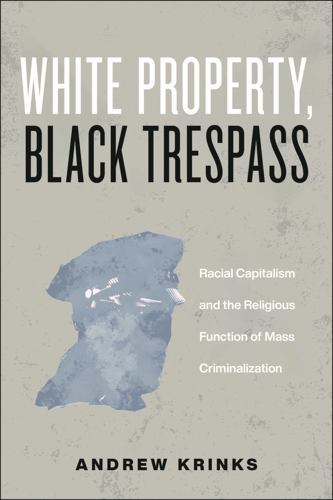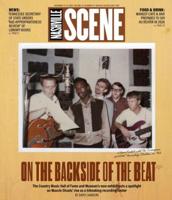
Andrew Krinks
I first met Andrew Krinks when he was an undergraduate at Lipscomb University. He was part of a loose community of folks committed to friendship and solidarity with one another despite the fact of incarceration: a mix of students, scholars, lawyers, caged and uncaged. Among them were Cyntoia Brown, Rahim Buford, Harmon Wray, Janet Wolf, Richard Goode, Preston Shipp, Jeannie Alexander and Krinks’ partner Lindsey Krinks.
Whether offering instruction through a megaphone at a demonstration, a poetry workshop at the Tennessee Prison for Women or in classrooms at TSU or Vanderbilt, Krinks appeals to people’s conscience and creativity with his own. His book White Property, Black Trespass examines mass incarceration and racial hierarchies through a spiritual lens, with a perspective rooted in the belief that “there is life beyond the present order of exploitation, dispossession, and death.” He answered questions by email.
You speak of whiteness as a religion, and you understand that clinging to “racial, gender, and class inheritances” as a means to wholeness is “spiritual death.” Could you say more about how whiteness is a religion and clinging to it is a form of death?
I understand religion as the myriad ways that humans attempt to transcend, transform and make ultimate meaning of the conditions of mortal finitude. People navigate and make sense of the human condition in quite different ways. This is why religion is and always has been many things, including both life-giving and death-making.
Whiteness constitutes a religion, first, because it came into being as an inhabitable idea in and through the theological reasoning and violent acts of dispossession carried out by early European Christian colonizers and capitalists. There was no such thing as “white people” before about 1700. There were English, French, Dutch, German and other people of European descent, but there was no such thing as a consolidated “white” identity.
Whiteness came into existence when European men of property defined themselves in absolute opposition to all others. This is why I understand whiteness as a pursuit of self-deification that ultimately results in self-debasement instead. It is an attempt to escape the world on the bent backs of those it sacrifices in pursuit of its transcendent power.

What words might you have for the white person who beholds your title and feels doomed?
I don’t believe that guilt motivates the kind of action needed to transform our world. So I’m not interested in making white people — myself included — feel bad as individuals for inheriting what amounts to a curse. I’m more interested in inviting people to locate pathways to a personhood beyond the confines of spiritual death, a personhood based on the truth that Fannie Lou Hamer and others named when they said that none of us are free until all of us are free.
What is the Doctrine of Discovery, and is it still on the books?
The Doctrine of Discovery — the idea that God invites people of European descent to conquer Indigenous people’s lands — and later John Locke’s rationalization of private possession as obedience to a God who commands humans to “subdue” the Earth led to incalculable levels of displacement and death over the course of centuries, both in Europe and on Turtle Island.
So what do criminalization and incarceration have to do with this history? Many of the tens of thousands of people displaced from commonly tenured lands in England a few centuries ago found themselves subject to labor and vagrancy laws that criminalized the refusal to be properly subject to capital. For centuries, those so criminalized were brutally tortured or even executed in public, often with clergy leading the procession. When the state moved away from public torture and execution for people’s state of dispossession, it transitioned toward what would eventually become the modern prison. The first prisons were full of poor folks. Very little has changed since then.
You propose data-driven approaches to harm that “refuse to eliminate people who have hurt others, recognizing that everyone who hurts someone in a significant, life-altering way are themselves survivors of some significant harm.” How did you arrive at this recognition?
I arrived at this first through relationships with criminalized and incarcerated people, which began for me about 15 years ago. Many of the incarcerated people I have known often say that “hurt people hurt people.” There is endless research showing that the vast majority of people who end up in prison are survivors of violence and usually of poverty as well. Police and prisons are definitionally incapable of disrupting violence, because police and prisons are explicitly based on the use of violence.
I love the way you frame “noncarceral modes of accountability” as ancient and also ascendant. How is it that so many of us imagine creatively nonviolent responses to harm as rare?
If we have ever accompanied a friend navigating emotional trauma or mental illness, talked someone down from verbal or physical retaliation after being hurt or apologized to a partner for saying or doing something harmful, then we already know some of the essential ingredients of safety that don’t resort to violence.
I believe that we lose sight of these things because the social order we live in depends upon our devotion to “public safety” in the form of state violence to maintain the hierarchies that grant power and wealth to a few, while subjecting many to perpetual vulnerability. People with a lot of power and wealth do whatever they can to protect and fund police because police are essential to the task of maintaining their power and wealth.
To read an uncut version of this interview — and more local book coverage — please visit Chapter16.org, an online publication of Humanities Tennessee. τ






